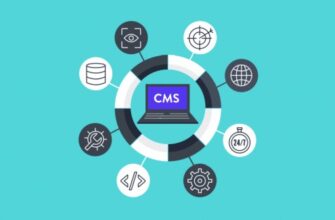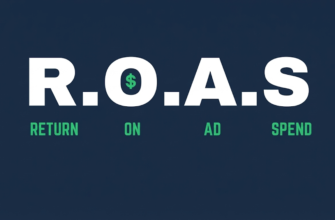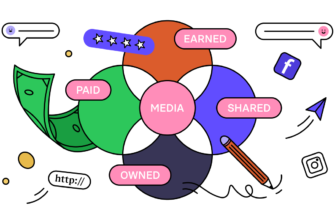- Which is better for an online store: Ecwid vs Shopify
- Convenience of the administrative panel
- Templates and themes
- Adding products
- Visual editor
- Dropshipping
- Plugins and extensions
- Sales for several regions
- Delivery configuration
- Payment system integration
- POS support
- Help Desk
- Which platform is better for promotion, Ecwid or Shopify?
- SEO optimization
- Blogging
- Email marketing
- Cost comparison between Ecwid and Shopify
- Prices for using Ecwid
- Shopify Pricing Plans
- What to choose, Shopify or Ecwid?
- Pros and cons of Shopify
- Advantages and disadvantages of Ecwid
Ecwid and Shopify are two popular platforms for creating online stores that make it easy and quick to launch a full-fledged online business without requiring special technical knowledge or the involvement of a programmer.
The main difference between the two is that Shopify is a standalone platform, while Ecwid is an Ajax-based widget that can be integrated with any website.
In this material we will consider the functionality, capabilities, cost and other important aspects of these services. We will conduct a detailed comparison of them so that you can determine which is better, Shopify or Ecwid is right for your business.
How many calls and sales will I get by ordering contextual advertising from you?
I need to calculate the conversion of my website Describe
the task
in the application
Calculate potential ad revenue Google
contextual advertising calculator
Which is better for an online store: Ecwid vs Shopify
To understand which is better for ecommerce, Ecwid or Shopify, you need to compare the key features that online store owners most often use for each platform.
Convenience of the administrative panel
The admin panel provides the online store owner with the ability to add and edit products, accept orders and set up integration with delivery services, analyze statistics, etc. The convenience of this interface largely determines how easy it will be to run an online store.
The Ecwid control panel is intuitive in design and easy to learn. All the necessary tools are available on one page, divided into categories. There are built-in tips for novice users:
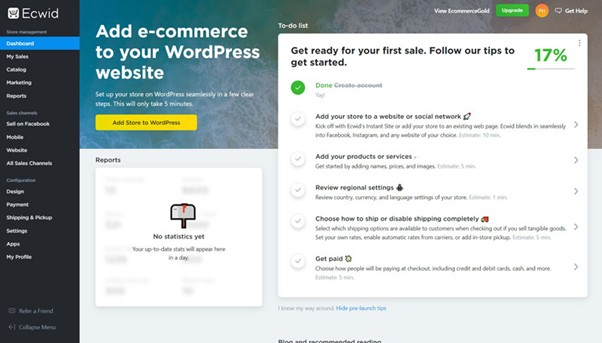
The Shopify interface is also logically organized, but the functionality is scattered across different pages, which makes navigation somewhat complicated. But there are a lot of video tutorials and articles in the knowledge base of this CMS:
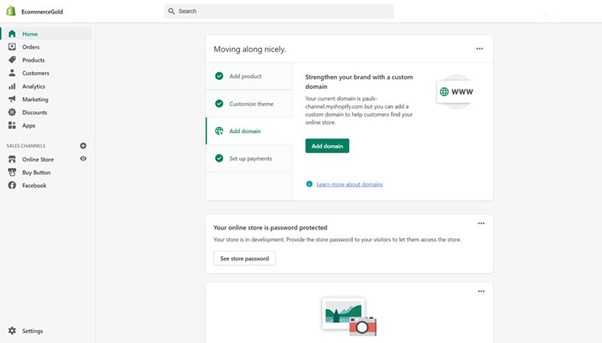
Templates and themes
The appearance and design of the store play a big role in attracting customers and increasing conversion. Ecwid provides the user with about 10 free templates. They look modern and are adapted for mobile devices. But you can only partially customize them to suit your tasks: colors, fonts, logos change:
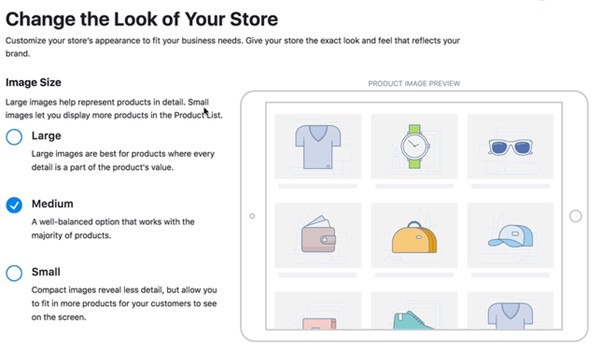
If you need a unique design, you will have to turn to third-party developers.
Shopify has many more theme options. The user can choose from more than 100 free and premium themes, which are divided into categories:

They can also be customized: change the page structure, add your own blocks and elements. With Shopify you can get almost any store design using your brand colors due to a large selection of templates and a multifunctional editor, but its competitor has limited these capabilities.
Adding products
The process of adding and managing products should be as simple and convenient as possible. Products can be added to Ecwid either one by one, filling in the fields manually, or in bulk – via CSV or XML files. There are fields for description, photo, characteristics and attributes. You can also group products by category and brand:
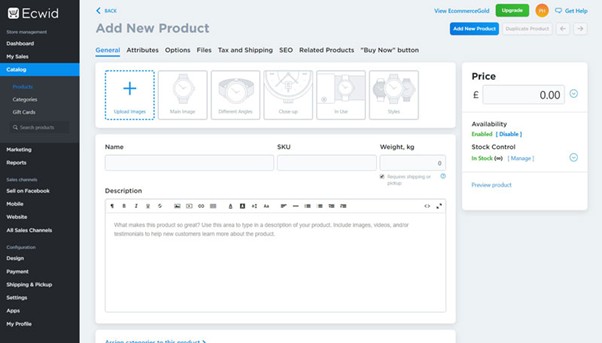
Shopify also allows you to add products manually or in bulk. The control functionality is similar – all the necessary characteristics are present. Additionally, the seller can connect reviews and ratings for products, newsletters for customers about the arrival of goods, and much more:

In terms of ease of assortment management, the platforms are approximately equal. At the same time, Shopify users have more opportunities to automate this process.
Visual editor
Ecwid does not have a full-fledged page builder – you can only add and remove blocks in a predefined template. You cannot change the arrangement of elements or add your own. You will have to involve a developer or look for an additional solution in the application store.

But in Shopify, a full-fledged visual editor is available that allows you to customize the design and structure of all pages. You can move, add, and remove any blocks—from text and photos to videos and forms. There are many widgets for displaying products, categories and reviews:

Dropshipping
Many online stores use the dropshipping model – when the seller places goods from suppliers on his website, and when ordering, redirects it directly to the dealer to be sent to the buyer. However, it is not necessary to have your own warehouse.
Ecwid allows you to set up store integration with dozens of dropshipping companies through apps. With the help of such developments, you can import an assortment of suppliers into your catalog or synchronize product balances in real time. When ordering, the buyer’s information will be automatically transferred to the supplier.
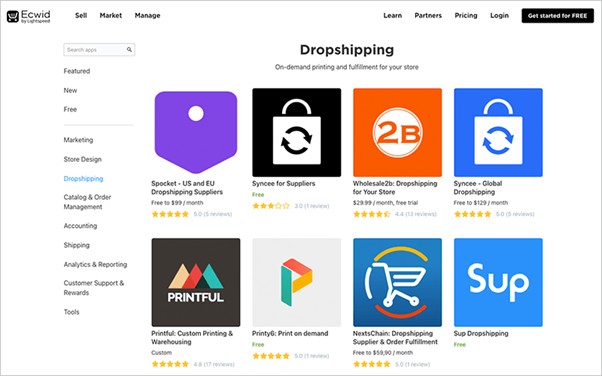
Shopify also has many dropshipping apps. In addition, the platform has built-in functionality for such a sales model, which is called “Supplier Processing”. It allows you to easily link a product to a specific supplier and automate the transfer of orders.
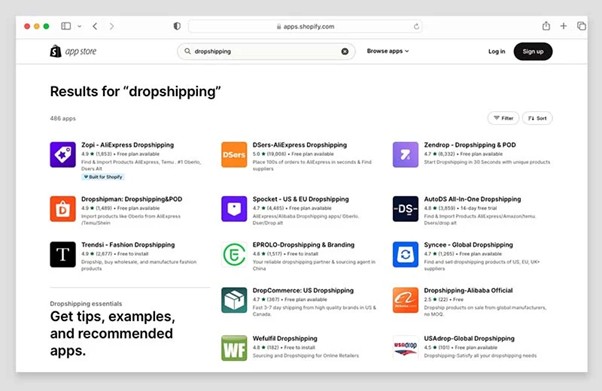
Plugins and extensions
Ecwid has its own App Market with more than 160 applications:

With their help, you can integrate with CMS, CRM, marketplaces, popular delivery services, analytics, etc. Most applications are free or have a free version with limited functionality.
The Shopify marketplace has about 6,000 apps for marketing automation, conversion optimization, and other tasks. Many of them are paid, but some plugins are distributed free of charge:
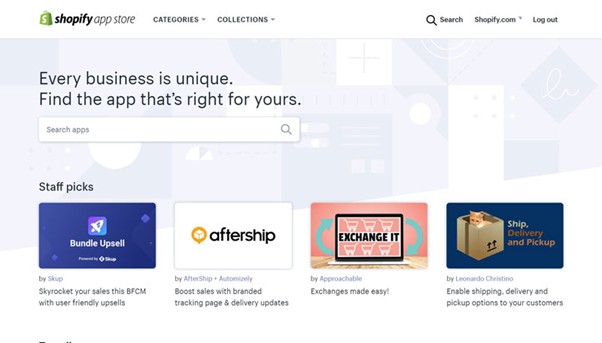
Sales for several regions
If your online store serves customers from different countries, it is important to have the ability to localize your business. Ecwid allows you to create a single store for several regions or a separate website for each country.
How many calls and sales will I get by ordering contextual advertising from you?
I need to calculate the conversion of my website Describe
the task
in the application
Calculate potential ad revenue Google
contextual advertising calculator
You can configure automatic display of the desired currency, interface language, payment methods and delivery services for different locations. The system can also automatically determine the country from which the visitor accessed the site.
In Shopify, you can also sell to several countries at once from one store. For each region, the language, currency, payment and delivery methods are configured. You can also translate the store into several languages using the built-in functionality. Thus, both platforms are suitable for multi-regional projects.
Delivery configuration
In the Ecwid admin panel, the seller can set up delivery through their own courier service; integration with popular courier and postal services, both local and international, is also available. The service can also automatically calculate the cost of transport services, depending on the region, weight of the goods and order amount.
Shopify offers similar functionality, but in addition there are opportunities to automate the process – printing labels, tracking parcels, synchronizing with the API of courier companies in real time, etc.
Payment system integration
The more popular payment systems your site supports, the greater the conversion will be. For example, Ecwid allows you to accept payments through more than 50 different gateways, including Visa, MasterCard, PayPal, LiqPay and others.
Shopify integrates with hundreds of payment providers in dozens of countries. The popular systems Visa, Mastercard, American Express, PayPal, as well as local systems for accepting payments are available. In terms of the number of connected services, Shopify holds a confident lead in comparison with its competitor.
At the same time, both platforms allow you to accept payments with major cards, electronic currencies and other common methods.
POS support
Both platforms under consideration are perfect for synchronizing online and offline sales. Thus, both Ecwid and Shopify provide their own mobile application, with which you can accept payments via a smartphone or tablet connected to a cash register and receipt printer:

At the same time, data on the sale of goods and balances is synchronized with the online store.
Help Desk
High-quality technical support is important for quickly resolving issues that arise when working with the platform. Ecwid allows you to contact the right specialist by email, online chat, or phone. Also on the website of this CMS there is a section with answers to popular questions. The average response time is about 15 minutes in chat and up to 24 hours by e-mail. Support is free on all plans.
Shopify customers have access to technical support through the same channels, but usually much faster. You can expect a response from a live chat technician within a couple of minutes, and emails can take no longer than a few hours to respond. The two most expensive plans offer 24/7 support.
Which platform is better for promotion, Ecwid or Shopify?
To understand which platform is better, Shopify or Ecwid, an important factor for comparison is the possibilities for website promotion. After all, when the project is ready to launch, it may turn out that the site is poorly indexed by search engines or there are no built-in capabilities for connecting email newsletters.
SEO optimization
Ecwid allows you to assign a unique title, meta description, and CNC URL for each page (both for products and categories, and for blog pages). In addition, schema.org structured data is supported to improve indexing of products in search results. There are also built-in analytics tools.
Its competitor also offers similar functionality, but the advantage is a more advanced analytical system and the ability to A/B testing to optimize site conversion.
Blogging
Creating and maintaining a blog on a website is one of the most effective tools for attracting organic traffic and increasing conversion. You can add your blog to Ecwid, which is much more convenient than running it on an external platform. This also allows you to develop the main site by receiving transitions from search engines for thematic queries.
Right in the platform’s administrative panel you can publish informational articles, add images and videos. It is possible to add these pages to the site map and add meta tags, as well as integration with social networks.
In Shopify, the blog must be connected through third-party applications. Among the most popular options is the Shopify Blog extension. It allows you to create an unlimited number of articles, as well as assign them the necessary categories and tags.
The main advantage of this application is the ability to customize the blog design completely to match the appearance of your site. Ecwid does not provide such functionality. But here you can create a blog without additional applications, as well as integrate products from the store into articles.
Email marketing
Email newsletters can significantly increase sales and conversion of an online store, and also increase the LTV of the customer base. Ecwid provides the ability to collect email addresses of subscribers and send them letters through a built-in service.
You can create notifications for users about a new order or shipment. In addition, ready-made templates for newsletters and marketing mailings are provided, as well as statistics on the number of clicks on links.
Shopify has more powerful functionality, which will be a real boon for large projects with thousands of subscribers. It provides the ability to segment the database by tags, order history and other parameters. You can also conduct A/B testing.
In addition, in the app store you can download solutions for integration with MailChimp, Klaviyo, Omnisend and other popular marketing services for better analytics and automation setup.
Cost comparison between Ecwid and Shopify
When comparing Shopify and Ecwid, the key point that online business owners usually pay attention to is the cost of using the platform. A lot depends on this, including the overall profitability of the company.
Prices for using Ecwid
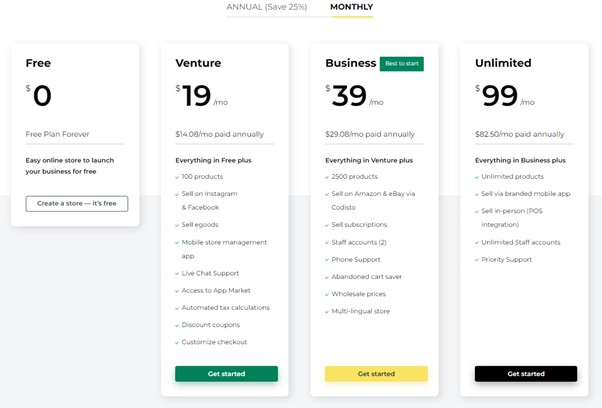
The platform offers its clients four tariff plans:
- Free. Allows you to add and sell 10 products. More suitable for getting to know the platform and learning its basic capabilities than for full use. But it might be a good choice for micro businesses.
- Venture ($19/month). This is a basic offer that allows you to sell up to 100 products at a time, connect your store to accounts on social networks Instagram and Facebook, and receive technical support via online chat. The platform charges a 3% commission on each payment.
- Business ($39/month). This is already a solution for medium-sized stores, allowing you to add up to 2,500 products to the catalog. With this plan, you can sell on eBay and Amazon, translate your store into multiple languages, and receive phone support. It also provides a reduced commission – 2% for each sale.
- Unlimited ($99/month). With the most expensive tariff, you can add an unlimited number of product items to the catalog, use the official mobile application with POS support, and add an unlimited number of accounts for site managers and administrators. Here the commission on sales is the lowest – only 1%.
All plans also include a 25% discount when paid annually.
Shopify Pricing Plans
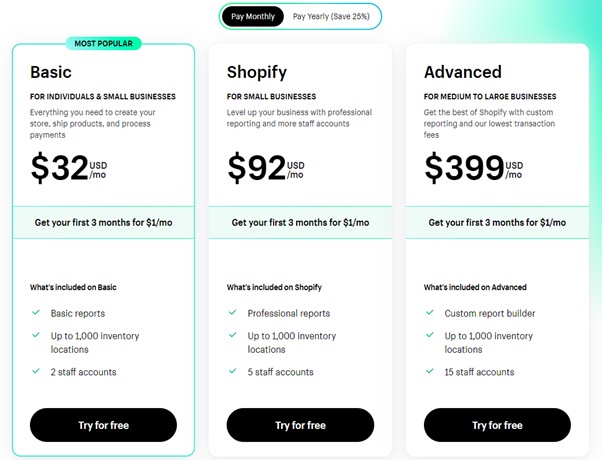
System users can choose one of three available tariffs:
- Basic ($32 monthly). This is the most popular tariff plan that covers the needs of most individual entrepreneurs and small businesses. Here you can add two accounts for the administrator, email newsletters, coupons and an affiliate program are also available.
- Shopify ($92 monthly). An excellent choice for developing stores, which offers the ability to add more products to the admin panel, connect 5 manager accounts, as well as a retargeting function and advanced reporting on sales and traffic.
- Advanced ($399 monthly). This is a solution for large projects, which includes the ability to upload up to 15,000 products to the site, create 15 accounts for staff, access to the API, as well as a dedicated manager from the platform for priority technical support.
What to choose, Shopify or Ecwid?
To decide whether to choose Ecwid or Shopify, you need to understand the pros and cons of each CMS.
Pros and cons of Shopify
The system has a lot of advantages:
- Wide marketing functionality. You can set up and launch email campaigns with segmentation and automation of the subscription base, retargeting on Facebook and Google, your own affiliate programs and much more.
- Unique design. You can design your store using one of hundreds of built-in templates. You can also customize a ready-made website to suit your needs, either by adding your own CSS styles and editing HTML, or by using ready-made widgets and content blocks.
- Built-in analytics tools. You can track any metrics – from traffic sources and user behavior to conversion. You can also optimize processes using split tests.
- More suitable for large projects. Websites with millions in turnover are launched on this engine. There are options for setting up multilingualism, localization and B2B sales.
- Integration with third-party services. There are several thousand ready-made applications available in the application store for synchronization with CRM, ERP, third-party payment gateways, instant messengers, etc.
Although you need to remember the disadvantages:
- Relatively high cost. This can be especially noticeable for small projects with a monthly turnover of less than $1000.
- Most plugins and add-ons are paid. In addition to the main subscription fee, you will have to purchase additional modules if you need expanded functionality.
- Fine-tuning requires knowledge of HTML and web design. If you want to change the design of the installed template to suit your needs, you will have to contact a programmer or master the layout yourself.
- Cloud solution. This is a SaaS product, so you won’t be able to move the site to your server or rewrite the code at your own discretion. You will be very tied to the platform and its developers.
- No free plan. Prices start at $32 per month, and you won’t be able to use the platform for free, unlike Ecwid.
Advantages and disadvantages of Ecwid
This CMS also has a lot of advantages, thanks to which it has many admirers:
- Low prices. For small projects, Ecwid is more profitable, because it provides a free tariff plan, and the basic one will cost about one and a half times less than Shopify.
- Easy to learn. The system has an intuitive interface and does not require special skills in web design and programming for effective management. This makes it much easier for beginning entrepreneurs to learn.
- Ready solutions for integration. The store can be integrated with your current website, social networks or account on popular marketplaces. Thus, you can add another platform for sales without bothering with development.
- Built-in marketing tools. For basic SEO optimization, email campaigns or the use of analytical systems, you do not need to buy or install third-party modules, everything is available out of the box.
But the system is not without some disadvantages:
- Functionality is limited for low-cost plans. The free plan allows you to add only a dozen products and does not reveal all the capabilities of the platform.
- Fewer advertising tools compared to Shopify. For example, there is no provision for connecting remarketing, there are no automated mailings, etc.
- Fewer ready-made themes. In addition, the built-in visual editor has limited capabilities for changing and modifying them.
- Work in the B2B segment has been severely curtailed. You will not be able to create separate accounts for wholesalers and dropshippers. There is also no possibility to connect corporate accounts, discounts, or work with legal entities.







